Improvement of the Grid-Tied Solar-Wind System with a Storage Battery for the Self-Consumption of a Local Object
Abstract
:1. Introduction
2. Literature Review and Problem Statement
- to calculate the average monthly values of the energy generated by PV and WG at time intervals of the day, using archived data for the LO location point;
- to develop a technique for calculating the installed power of the equipment for the LO load schedule in question with a given reduction in electricity consumption from the grid;
- to formulate principles for the implementation of a schedule for the SB charge degree, accounting for the forecasted RES generation with one or two electricity payment tariffs;
- to perform simulation modeling of energy processes in the system for the daily cycle of work, with an assessment of the degree of reduction in costs for electricity consumed from the grid.
3. Materials and Methods
4. Research Results on Improving the Grid-Tied PV-WG System with a Battery
4.1. Structure of PV-WG System
4.2. Analysis of RES Generation Based on Archival Data: The Accepted Load Schedule
4.3. Implementation Variant for One-Tariff Plan
4.4. Formation of Storage Battery SOC(t) Dependency in Two-Tariff Plan Case and Use of Night Battery Charge from the Grid
- If Q*2R ≤ Q*d, the charge current does not depend on the state of charge. We refer the current at forecast intervals, for example, Δt = 1 h − I1B = (0.01·CB·(Q*2R − Q*t))/(t − t2). At the initial point in time t = t6, the current value t, Q*t and reference of the current I1B are then used;
- When the RES generation is high and a night charge is not required (Q*2R ≈ Q*6) or the charge is negligible, and value [(WW62 + WPV62)·ηC − WL62] > 0, that value of the SB charge current is
- If Q*2R > Q*d, the battery is charged in two stages: up to 90%, followed by charging at a current value according to the charging characteristic up to Q*2 ≤ 95%, when IB ≥ (0.09–0.1)·CB. In the case of maximum generation of WG (wind gust) and reduction of the load to 0, the value that can be obtained is I1B = PWMAX·ηC/UB ≤ 0.083CB.
4.5. System Operation Modes
5. Modeling the Energy Processes in the Daily Cycle
6. Discussion
- use of WG at the average wind speed for the location of the LO as an auxiliary source of energy of low power. At the same time, WG increases the value of the total generation of RES in winter to a value that provides the desired reduction in consumption from the grid. This value is close to spring and autumn periods in the absence of wind;
- calculation of the installed power of the equipment for the accepted LO load schedule, with the desired reduction in electricity consumption from the grid, based on the monthly average values of the energy generated by PV and WG. The values are determined by time intervals per day using archival data for the LO location point;
- formation of a state of charge SOC(t) according to the short-term forecast of RES energy generation, taking into account the tariffication of payment for electricity and with a focus on minimizing the nighttime charge, as well as using only one deep discharge cycle per day.
- the object is accepted with the main load in the daytime in the presence of peak loads in the morning and evening hours when it is possible to charge the battery at night within the limit on consumption from the grid. The average value of the load power at intervals is close to the accepted schedule;
- the assessment of a possible reduction in the cost of paying for electricity during the year was somewhat simplified. During the simulation, the days were considered when the PV generation corresponded to the monthly average values for the set time intervals, paired with the actual WG generation for the selected days;
- implementation of the control system implies an “open” structure of the relevant regulatory channels;
- the simulation assumed that the graph of the power generated by PV corresponded to the forecast and did not change during the day.
- automation of the calculation of data for the average monthly generation of renewable energy sources;
- a study of the possibilities for correcting deviations in the values of the actual generation of renewable energy sources relative to the forecasted data, and possible changes to the current forecast during the day;
- improvement of the principles for the implementation of the control system.
7. Conclusions
Author Contributions
Funding
Institutional Review Board Statement
Informed Consent Statement
Data Availability Statement
Acknowledgments
Conflicts of Interest
Nomenclature
| PV | Photovoltaic battery |
| WG | Wind generator |
| RES | Renewable energy sources |
| SB | Storage battery |
| LO | Local object |
| DG | Distribution grid |
| PCC | Point of common coupling |
| MPPT | Maximum power point tracking |
| PPV | PV power generation (W) |
| PW | Power generation of the wind generator (W) |
| PL | Load power (W) |
| Pg | Power consumption from the grid (W) |
| PPVR | Rate (installed) power of photovoltaic battery (W) |
| PWR | Rate (installed) power of wind generator (W) |
| Ud | DC link voltage (V) |
| UB | Battery voltage (V) |
| Ug | Grid voltage (V) |
| IB | Current of battery (A) |
| Ig | Current at point of common coupling with the grid (A) |
| IPV | Current of photovoltaic battery (A) |
| WPV | Energy generation of photovoltaic battery (Wh) |
| WW | Energy generation of wind generator (Wh) |
| WR | Total energy generation of photovoltaic battery and wind generator (Wh) |
| WB | Battery energy capacity (Wh) |
| Wg | Energy consumption from the grid (Wh) |
| WL | Load energy consumption (Wh) |
| WPVAVD | Average value of energy, generated by photovoltaic battery per day (Wh) |
| WWA VD | Average value of energy, generated by wind generator per day (Wh) |
| CB or QR | Capacity of battery or rated state of charge (Ah) |
| Q* | Battery state of charge (%) |
| Q*d | Battery state of charge when switching to constant voltage charge mode (%) |
| ηC | Overall efficiency of converter and inverter (p.u.) |
| ηB | Battery efficiency (p.u.) |
| mP | Coefficient of recalculation of photovoltaic battery power (p.u.) |
| m | Coefficient of recalculation of wind power (p.u.) |
| kE | Cost reduction factor for the energy consumed from the grid (p.u.) |
| t, t1, t2… t7 | Time points for load schedule [h] |
| Td | Day tariff rate (p.u.) |
| Tn | Night tariff rate (p.u.) |
References
- Kartite, J.; Cherkaoui, M. Study of the different structures of hybrid systems in renewable energies: A review. Energy Procedia 2019, 157, 323–330. [Google Scholar] [CrossRef]
- Ramoji, S.K.; Rath, B.B.; Kumar, D.V. Optimum Design of a Hybrid PV/Wind Energy System Using Genetic Algorithm (GA). IOSR J. Eng. 2014, 4, 38–48. [Google Scholar] [CrossRef]
- Kumar, N.M.; Chopra, S.S.; Chand, A.A.; Elavarasan, R.M.; Shafiullah, G.M. Hybrid Renewable Energy Microgrid for a Residential Community: A Techno-Economic and Environmental Perspective in the Context of the SDG7. Sustainability 2020, 12, 3944. [Google Scholar] [CrossRef]
- Kamjoo, A.; Maheri, A.; Putrus, G.A.; Dizqah, A.M. Optimal Sizing of Grid-Connected Hybrid Wind-PV Systems with Battery Bank Storage. In Proceedings of the World Renewable Energy Forum, WREF 2012, Including World Renewable Energy Congress XII and Colorado Renewable Energy Society (CRES), Denver, CO, USA, 13–17 May 2012; pp. 2492–2499. [Google Scholar]
- Menniti, D.; Pinnarelli, A.; Sorrentino, N. A Method to Improve Microgrid Reliability by Optimal Sizing PV/Wind Plants and Storage Systems. In Proceedings of CIRED 2009—The 20th International Conference and Exhibition on Electricity Distribution—Part 2, Prague, Czech Republic, 8–11 June 2009; p. 1. [Google Scholar] [CrossRef] [Green Version]
- Yang, B.; Guo, Y.; Xiao, X.; Tian, P. Bi-level Capacity Planning of Wind-PV-Battery Hybrid Generation System Considering Return on Investment. Energies 2020, 13, 3046. [Google Scholar] [CrossRef]
- Shavolkin, O.; Shvedchykova, I. Improvement of the Multifunctional Converter of the Photoelectric System with a Storage Battery for a Local Object with Connection to a Grid. In Proceedings of the 2020 IEEE KhPI Week on Advanced Technology, KhPIWeek 2020, Kharkiv, Ukraine, 5–10 October 2020; pp. 287–292. [Google Scholar] [CrossRef]
- Shavelkin, A.; Jasim, J.M.J.; Shvedchykova, I. Improvement of the current control loop of the single-phase multifunctional grid-tied inverter of photovoltaic system. East. Eur. J. Enterp. Technol. 2019, 6, 14–22. [Google Scholar] [CrossRef]
- Belaidi, R.; Haddouche, A. A multi-function grid-connected PV system based on fuzzy logic controller for power quality improvement. Przeg. Elektr. 2017, 93, 118–122. [Google Scholar] [CrossRef] [Green Version]
- Vigneysh, T.; Kumarappan, N. Grid interconnection of renewable energy sources using multifunctional grid-interactive converters: A fuzzy logic based approach. Electr. Power Syst. Res. 2017, 151, 359–368. [Google Scholar] [CrossRef]
- Lliuyacc, R.; Mauricio, J.M.; Gomez-Exposito, A.; Savaghebi, M.; Guerrero, J.M. Grid-forming VSC control in four-wire systems with unbalanced nonlinear loads. Electr. Power Syst. Res. 2017, 152, 249–256. [Google Scholar] [CrossRef] [Green Version]
- Shavolkin, O.; Shvedchykova, I.; Kravchenko, O. Three-Phase Grid Inverter for Combined Electric Power System with a Photovoltaic Solar Battery. In Proceedings of the 2019 IEEE International Conference on Modern Electrical and Energy Systems, MEES 2019, Kremenchuk, Ukraine, 23–25 September 2019; pp. 318–321. [Google Scholar] [CrossRef]
- Shavolkin, O.; Shvedchykova, I. Improvement of the Three-Phase Multifunctional Converter of the Photoelectric System with a Storage Battery for a Local Object with Connection to a Grid. In Proceedings of the 25th IEEE International Conference on Problems of Automated Electric Drive. Theory and Practice, PAEP 2020, Kremenchuk, Ukraine, 21–25 September 2020; p. 9240789. [Google Scholar] [CrossRef]
- Conext, S.W. Hybrid Inverter. Available online: https://www.se.com/ww/en/product-range-presentation/61645-conext-sw/ (accessed on 1 May 2022).
- Zsiborács, H.; Pintér, G.; Vincze, A.; Birkner, Z.; Baranyai, N.H. Grid balancing challenges illustrated by two European examples: Interactions of electric grids, photovoltaic power generation, energy storage and power generation forecasting. Energy Rep. 2021, 7, 3805–3818. [Google Scholar] [CrossRef]
- Shavelkin, A.A.; Gerlici, J.; Shvedchykova, I.O.; Kravchenko, K.; Kruhliak, H.V. Management of power consumption in a photovoltaic system with a storage battery connected to the network with multi-zone electricity pricing to supply the local facility own needs. Electr. Eng. Electromech. 2021, 2, 36–42. [Google Scholar] [CrossRef]
- Shavolkin, O.; Shvedchykova, I.; Demishonkova, S.; Pavlenko, V. Increasing the efficiency of hybrid photoelectric system equipped with a storage battery to meet the needs of local object with generation of electricity into grid. Przeg. Elektr. 2021, 97, 144–149. [Google Scholar] [CrossRef]
- Forecast.Solar. Available online: https://forecast.solar/ (accessed on 1 May 2022).
- Iyengar, S.; Sharma, N.; Irwin, D.; Shenoy, P.; Ramamritham, K. SolarCast—An Open Web Service for Predicting Solar Power Generation in Smart Homes. In Proceedings of the 1st ACM Conference on Embedded Systems for Energy-Efficient Buildings, BuildSys 2014, Memphis, TN, USA, 3–6 November 2014; pp. 174–175. [Google Scholar] [CrossRef]
- Central Geophysical Observatory Named after Boris Sreznevsky. Available online: http://cgo-sreznevskyi.kyiv.ua/index.php?lang=en&fn=k_klimat&f=kyiv (accessed on 1 July 2022).
- Vetrogenerator. Available online: http://vetrogenerator.com.ua/base/map/12-karta-vetrov-ukrainy.html (accessed on 1 July 2022).
- Photovoltaic Geographical Information System. Available online: https://re.jrc.ec.europa.eu/pvg_tools/en/tools.html#SA (accessed on 1 May 2022).
- Nicolson, M.L.; Fell, M.J.; Huebner, G.M. Consumer demand for time of use electricity tariffs: A systematized review of the empirical evidence. Renew. Sustain. Energy Rev. 2018, 97, 276–289. [Google Scholar] [CrossRef]
- Davis, M.J.M.; Hiralal, P. Batteries as a Service: A New Look at Electricity Peak Demand Management for Houses in the UK. Procedia Eng. 2016, 145, 1448–1455. [Google Scholar] [CrossRef]
- Badawy, M.O.; Cingoz, F.; Sozer, Y. Battery Storage Sizing for a Grid Tied PV System Based on Operating Cost Minimization. In Proceedings of the ECCE 2016—IEEE Energy Conversion Congress and Exposition, Milwaukee, WI, USA, 18–22 September 2016; p. 7854896. [Google Scholar] [CrossRef]
- Krishnamoorthy, M.; Periyanayagam, A.D.V.R.; Santhan Kumar, C.; Praveen Kumar, B.; Srinivasan, S.; Kathiravan, P. Optimal Sizing, Selection, and Techno-Economic Analysis of Battery Storage for PV/BG-based Hybrid Rural Electrification System. IETE J. Res. 2020, 1–16. [Google Scholar] [CrossRef]
- Traore, A.; Taylor, A.; Zohdy, M.; Peng, F. Modeling and Simulation of a Hybrid Energy Storage System for Residential Grid-Tied Solar Microgrid Systems. J. Power Energy Eng. 2017, 5, 28–39. [Google Scholar] [CrossRef] [Green Version]
- VaultTec. Vertical WG. Available online: https://vaulttec.org.ua/p559274110-vertikalnyj-vetrogenerator-kvt.html (accessed on 1 May 2022).
- Data Sheet. Lithium Iron Phosphate Battery (LiFePO4) 12.8V 150Ah. Available online: https://www.eco-greenenergy.com/wp-content/uploads/2021/12/EGE-LiFePO4-Battery-12.8V150Ahd.pdf (accessed on 1 May 2022).
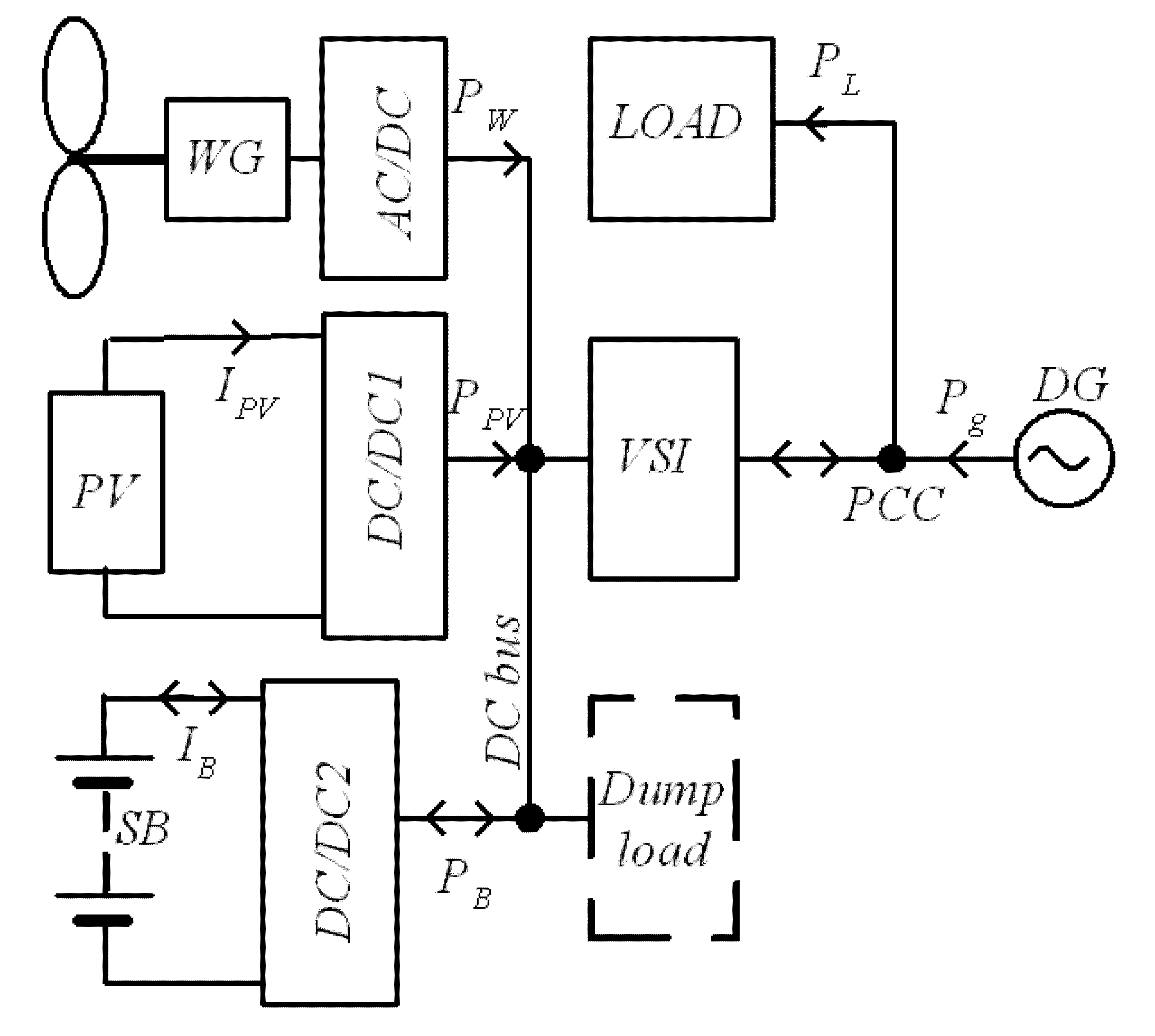
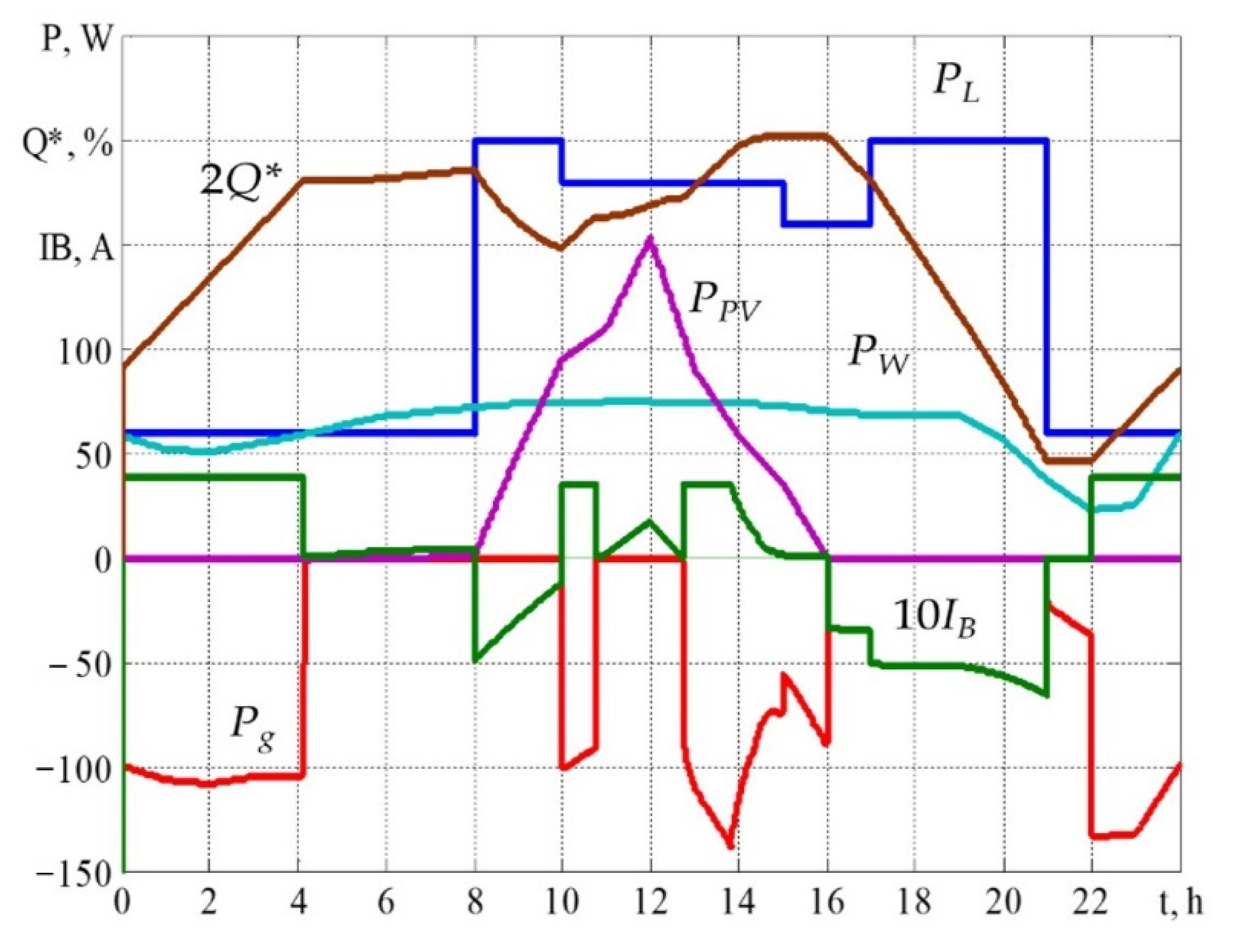
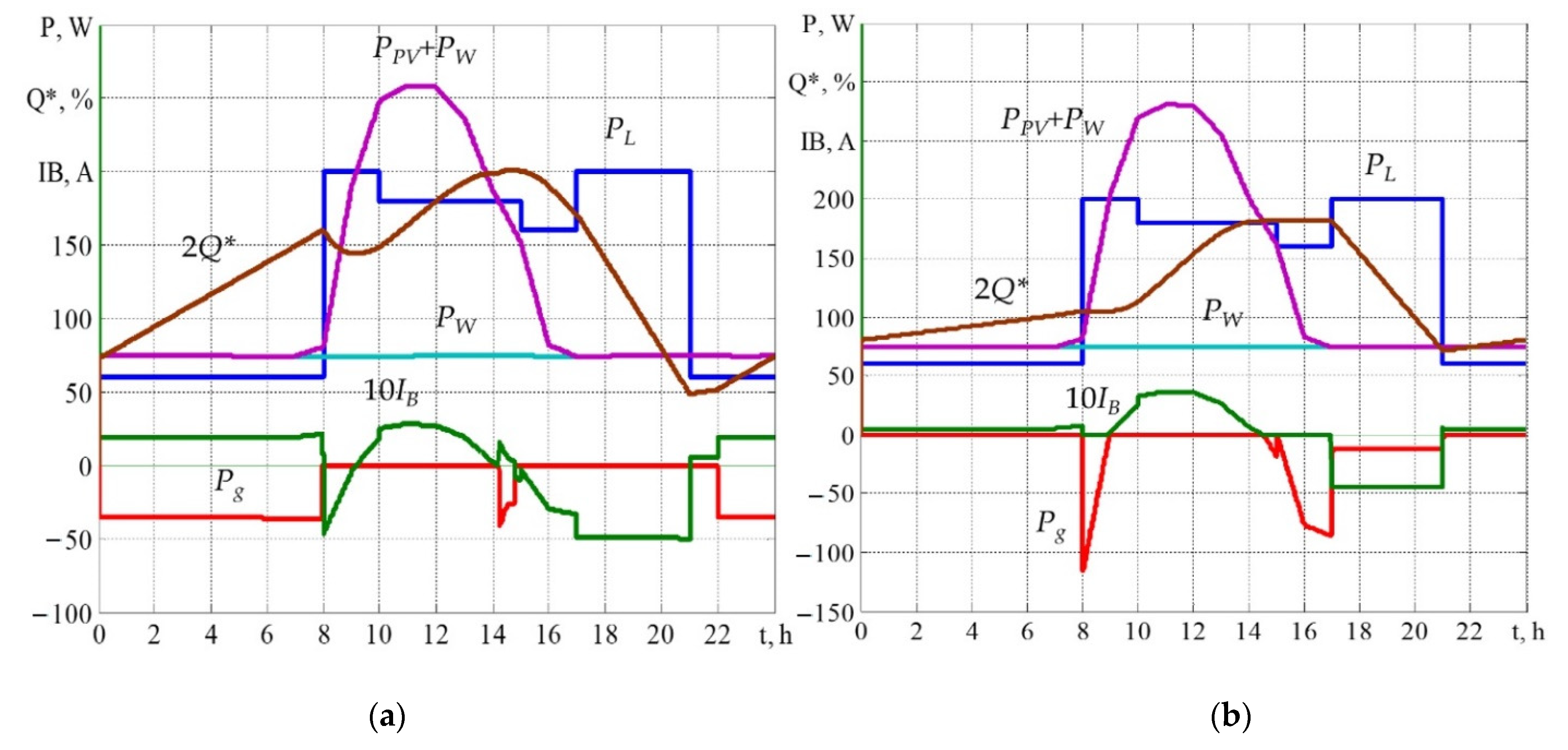
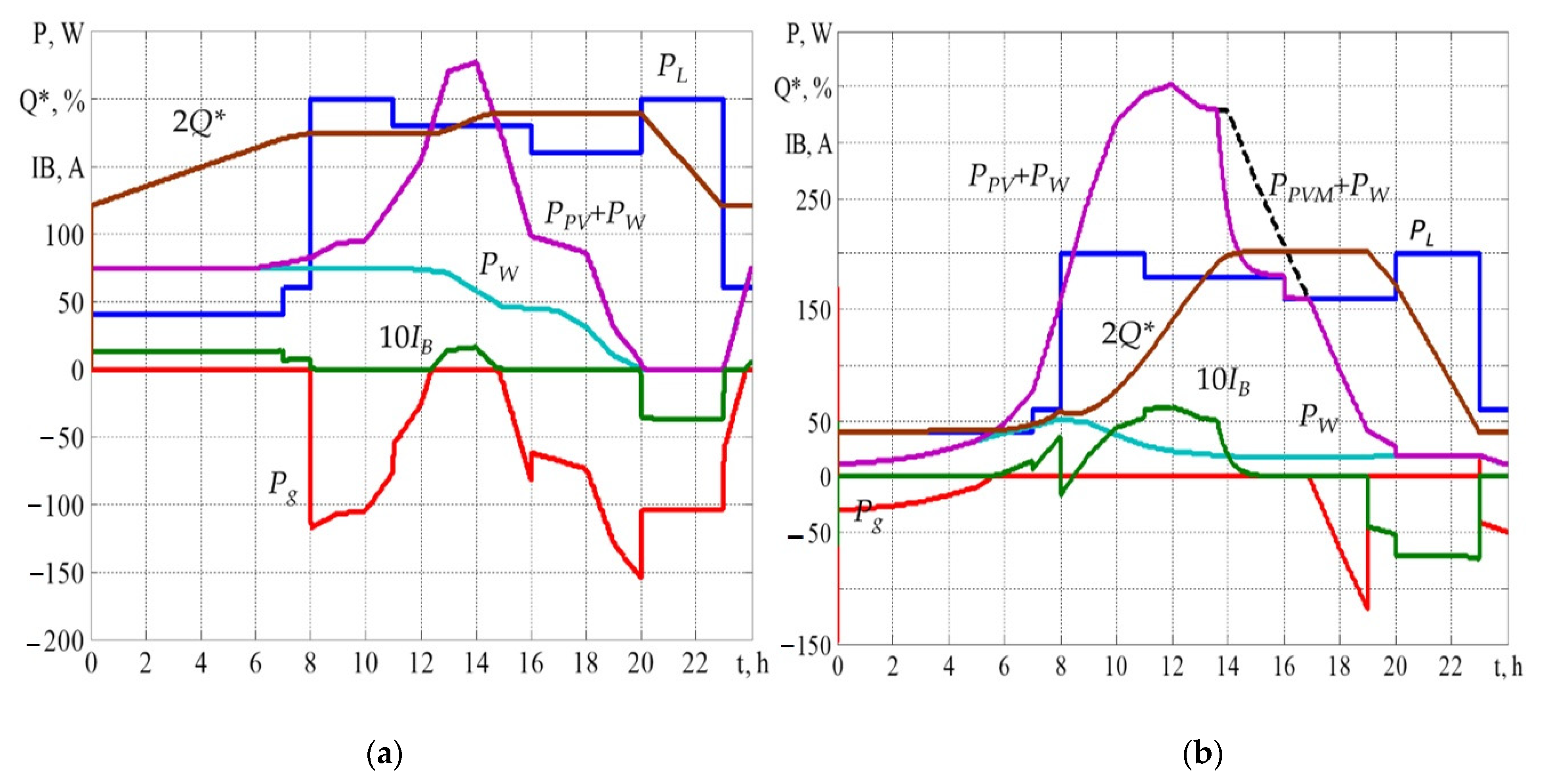
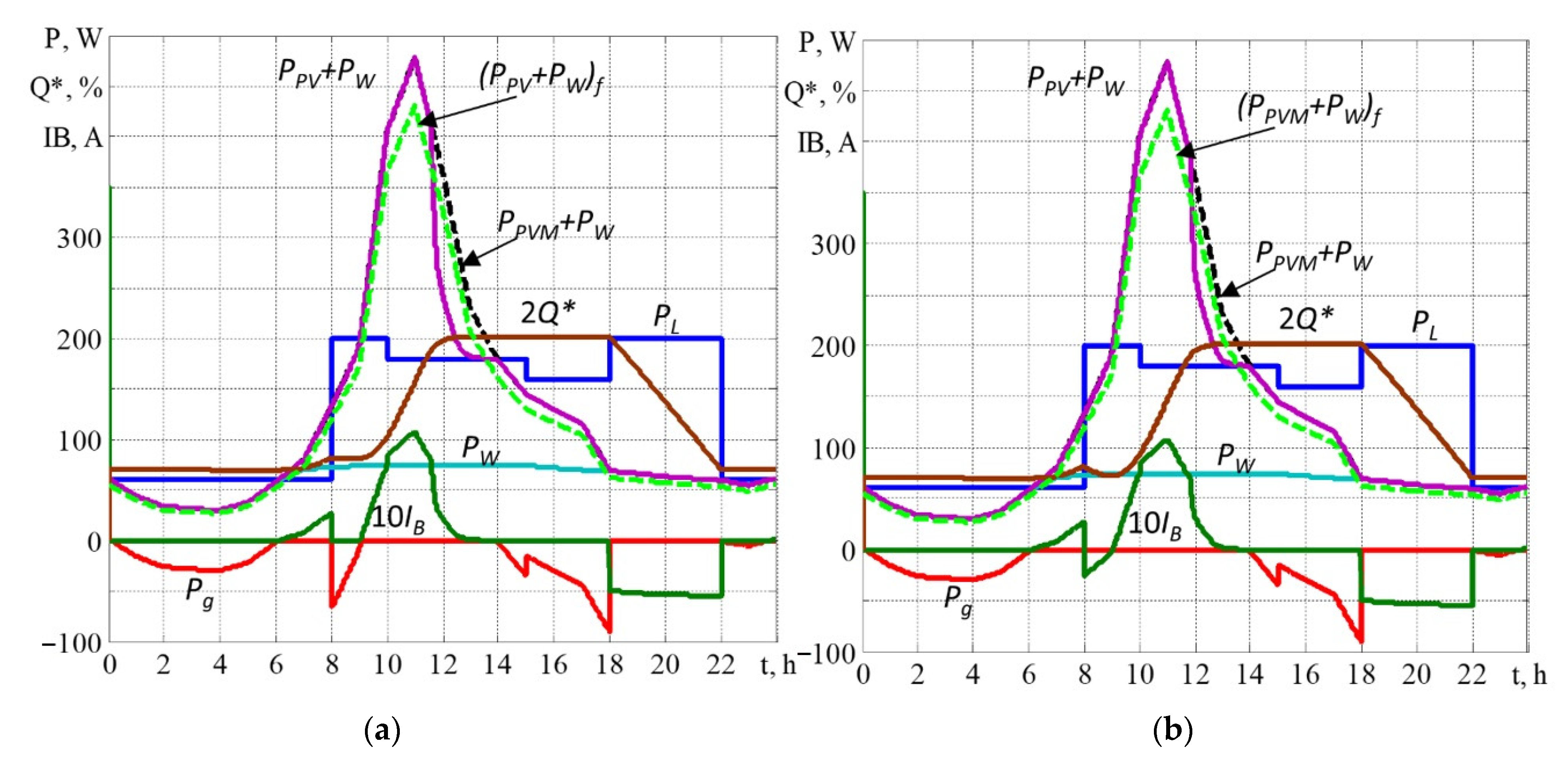
| Interval | (t1, t2) | (t2, t3) | (t3, t4) | (t4, t5) | (t5, t6) | (t6, t7) | (t7, t1) |
|---|---|---|---|---|---|---|---|
| Months | Load Power PL | ||||||
| May, June, July, August (t1 = 7.00, t2 = 8.00, t3 = 11.00, t4 = 16.00, t5 = 20.00, t6 = 23.00, t7 = 24.00) | PL12 = 0.3PL | PL23 = PL | PL34 = 0.9PL | PL45 = 0.8PL | PL56 = PL | PL67 = 0.3PL | PL71 = 0.2PL |
| November, December, January, February (t1 = 6.00, t2 = 8.00, t3 = 10.00, t4 = 15.00, t5 = 17.00, t6 = 21.00, t7 = 23.00) | PL12 = 0.3PL | PL23 = PL | PL34 = 0.9PL | PL45 = 0.8PL | PL56 = PL | PL67 = 0.3PL | PL71 = 0.3PL |
| March, April, September, October (t1 = 6.00, t2 = 8.00, t3 = 10.00, t4 = 15.00, t5 = 18.00, t6 = 22.00, t7 = 23.00) | PL12 = 0.3PL | PL23 = PL | PL34 = 0.9PL | PL45 = 0.8PL | PL56 = PL | PL67 = 0.3PL | PL71 = 0.3PL |
| Month | Jan. | Feb. | Mar. | Apr. | May | Jun. | Jul. | Aug. | Sep. | Oct. | Nov. | Dec. |
|---|---|---|---|---|---|---|---|---|---|---|---|---|
| WPVAVDK, kWh | 1.34 | 2.12 | 3.47 | 4.171 | 0.98 | 1.81 | 2.83 | 3.83 | 4.26 | 4.48 | 4.37 | 1.14 |
| WPVAVD, kWh | 0.98 | 1.81 | 2.83 | 3.83 | 4.26 | 4.48 | 4.37 | 4.16 | 3.52 | 2.49 | 0.96 | 1.03 |
| WPV23, kWh | 0.166 | 0.31 | 0.55 | 0.52 | 1.15 | 1.17 | 1.13 | 1.08 | 0.56 | 0.33 | 0.22 | 0.21 |
| WPV34, kWh | 0.78 | 1.31 | 1.84 | 2.38 | 2.43 | 2.27 | 2.5 | 2.45 | 2.27 | 1.74 | 0.69 | 0.8 |
| WPV45, kWh | 0.038 | 0.16 | 0.32 | 0.84 | 0.53 | 0.63 | 0.61 | 0.53 | 0.72 | 0.39 | 0.03 | 0.021 |
| WWAVD, kWh | 37.51 | 35.72 | 38.531 | 33.485 | 29.789 | 32 | 29.8 | 28.429 | 32.97 | 31.897 | 34.122 | 37.93 |
| WW56, kWh | 6.33 | 5.88 | 6.32 | 5.53 | 3.3 | 3.35 | 3.29 | 3.17 | 5.245 | 5.3 | 5.5 | 6.32 |
| WW62, kWh | 17 | 16.3 | 15.55 | 13.3 | 10.05 | 10.1 | 9.7 | 9.5 | 12.9 | 12.6 | 14.9 | 17.1 |
| WW24, kWh | 9.4 | 9.06 | 11.75 | 10.2 | 11.15 | 12.34 | 11.37 | 10.45 | 10.56 | 9.86 | 9.24 | 9.67 |
| Coefficient | Calculated Values, p.u. | ||||
|---|---|---|---|---|---|
| mp | 0.555 | 0.598 | 0.63 | 0.67 | 0.716 |
| kE (December) | 2.63 | 2.73 | 2.808 | 2.9 | 3 |
| kE (Spring-Autumn) | 2.63 | 3 | 3.4 | 4 | 5.09 |
| Interval Variable | (t6, t2), t62 | (t2, tR), t2R | tR < t5, (tR, t6), fR | tR ≥ t5, (t5, t6), hR | |
|---|---|---|---|---|---|
| Pg | If PR·ηC > PL, I1gm = 0, Pg = 0 | If PR·ηC > PL, I1gm = 0, Pg = 0 | If PR·ηC > PL, I1gm = 0, Pg = 0 | I1gm = 0, Pg = 0 | |
| If PR·ηC ≤ PL, VCIg → I1gm ≥ 0, Pg = (PRηC − PL) ≤ 0 | If PR·ηC ≤ PL, VCIg → I1gm ≥ 0, Pg = (PRηC − PL) ≤ 0 | If PR·ηC ≤ PL, VCIg → I1gm ≥ 0, Pg = (PRηC − PL) ≤ 0 | |||
| Reference I1PV | MPPT PPV = PPVM | MPPT PPV = PPVM | VCIPV →I1PV →PPVF, PPVFηC + PWηC = PL + PB | MPPT PPV = PPVM | MPPT PPV = PPVM |
| MPPT PPV = PPVM | |||||
| Reference I1B | IB= IB(Q*) | VCIB → I1B, IB = PL/UB | I1B= PB/UB | ||
| IB = 0 | IB = 0 | IB = 0 | |||
| SOC | Q*6→ Q*2 | Q* ≤ Q*d | Q* > Q*d | Q* → Q*6 | Q* → Q*6 |
| Interval Variable | (t1, t2), t62 | (t2, t3), t23 | (t3, tR), t3R | (tR, t6), t56 | |
|---|---|---|---|---|---|
| Pg | Pg≤ 0, Pg = (PRηC − PB − PL) | I1gm = 0, Pg = 0 | If PRηC ≥ PL, I1gm = 0, Pg = 0 | If PRηC ≥ PL, I1gm = 0, Pg = 0 | I1gm = 0, Pg = 0 |
| If PRηC < PL, VCIg → I1gm, ≥ 0, Pg = PPVηC − PL − PB ≤ 0 | If PRηC < PL, VCIg → I1gm ≥ 0, Pg = PPVηC − PL − PB ≤ 0 | ||||
| Reference I1PV | MPPT PPV = PPVM | MPPT PPV = PPVM | MPPT PPV = PPVM | VCIPV →I1PV → PPVF PPVFηC + PWηC = PL + PB | MPPT PPV = PPVM |
| MPPT PPV = PPVM | |||||
| Reference I1B | VCIB → I1B ≥ 0, if Q* ≤ Q*d, IB = IBREF if Q* > Q*d, IB ≤ IB(Q*) | IB = IB(Q*) | VCIB → I1B IB = PL/UB | ||
| I1B = 0.1CB | I1B = 0.1CB, IB = IB(Q*) | ||||
| SOC | Q*6→ Q*2 | Q*2→ Q*3 | Q* ≤ Q*d | Q* > Q*d | Q* → Q*6 |
| Indicator | Jan. | Feb. | Mar. | Apr. | May | Jun. | Jul. | Aug. | Sep. | Oct. | Nov. | Dec. |
|---|---|---|---|---|---|---|---|---|---|---|---|---|
| One tariff, without a night charge from the grid, mP = 0.67 (+ consumption from the grid is practically absent) | ||||||||||||
| ΔQ*MAX, % | 17.03 | 50.8 | 80 | 80 | 60 | 80 | 80 | 80 | 80 | 80 | 12.6 | 9.32 |
| kE1 | 3.904 | 13.49 | 15.39 | 32.14 | + | 14.77 | 11.31 | 40.54 | 4.34 | 8.164 | 3.8 | 3.132 |
| One tariff, without a night charge from the grid, mP = 0.6 | ||||||||||||
| ΔQ*MAX, % | 12.1 | 40.8 | 69 | 80 | 80 | 80 | 80 | 80 | 71 | 78.5 | 12.3 | 6.72 |
| kE1 | 3.637 | 9.275 | 9.67 | 26.48 | + | 14.16 | 10.36 | 32.86 | 3.807 | 7.356 | 3.53 | 2.93 |
| Night charge, two tariffs, mP = 0.6 | ||||||||||||
| kE1 | 3.2 | 7.637 | 9.811 | 26.8 | + | 16.28 | 10.52 | + | 3.706 | 7.66 | 3.149 | 2.745 |
| kEn | 3.678 | 11 | 13.24 | 27.23 | + | 27.49 | 12.56 | + | 4.716 | 7.276 | 3.505 | 3,43 |
| Night charge, two tariffs, mP = 0.67 | ||||||||||||
| kE1 | 3.393 | 11.9 | 15.39 | 32.3 | + | 16.37 | 11.25 | + | 4.447 | 8.164 | 3.321 | 2.918 |
| kEn | 3.933 | 16 | 20.64 | 33.4 | + | 27.73 | 13.65 | + | 5.483 | 7.764 | 3.736 | 3.64 |
Publisher’s Note: MDPI stays neutral with regard to jurisdictional claims in published maps and institutional affiliations. |
© 2022 by the authors. Licensee MDPI, Basel, Switzerland. This article is an open access article distributed under the terms and conditions of the Creative Commons Attribution (CC BY) license (https://creativecommons.org/licenses/by/4.0/).
Share and Cite
Shavolkin, O.; Shvedchykova, I.; Kolcun, M.; Medved’, D. Improvement of the Grid-Tied Solar-Wind System with a Storage Battery for the Self-Consumption of a Local Object. Energies 2022, 15, 5114. https://doi.org/10.3390/en15145114
Shavolkin O, Shvedchykova I, Kolcun M, Medved’ D. Improvement of the Grid-Tied Solar-Wind System with a Storage Battery for the Self-Consumption of a Local Object. Energies. 2022; 15(14):5114. https://doi.org/10.3390/en15145114
Chicago/Turabian StyleShavolkin, Olexandr, Iryna Shvedchykova, Michal Kolcun, and Dušan Medved’. 2022. "Improvement of the Grid-Tied Solar-Wind System with a Storage Battery for the Self-Consumption of a Local Object" Energies 15, no. 14: 5114. https://doi.org/10.3390/en15145114






